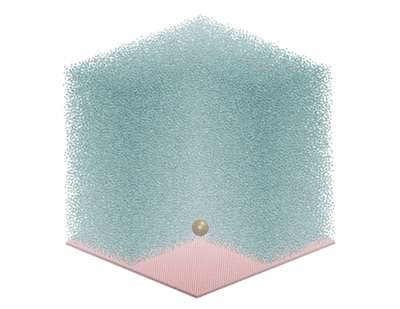Researchers settle long-standing debate about fundamental behavior of shaking particles

Particles floating in fluid perpetually flit about in all directions, a phenomenon referred to as Brownian motion. For example, proteins within our cells and pigment particles inside ink-jet printers wriggle and twitch their way through narrow channels of liquid circumscribed by solid surfaces.
Yet, unyielding interfaces alter Brownian motion for adjacent objects in liquid—and scientists have not been able to reach a consensus on exactly how those particles behave.
Now, however, University of Wisconsin-Madison materials engineers have definitively settled the dispute.
Izabela Szlufarska, a professor of materials science and engineering at UW-Madison, and her student Kai Huang, drew on a powerful computational approach called molecular dynamics to, in essence, model every atom and molecule in a liquid and solid interface. In the process, they unambiguously defined Brownian motion at that interface. Szlufarska and Huang published news of the advance in the Oct. 6, 2015, edition of the journal Nature Communications.
Brownian motion itself historically presented a puzzle to top scientific minds. Albert Einstein postulated that the twitchy trajectory is entirely random, theorizing that humans would never be able to measure the millions of minute changes in velocity that move microscopic objects. Recently, however, advanced instruments such as optical tweezers allowed researchers to measure those tiny velocity changes and demonstrate that there is a non-random contribution to Brownian motion. In other words, a particle has a memory of the path it has taken. This memory has a strong influence on the particle's future direction—and, interfaces alter the memory of the particle.
However, divisions among researchers persisted about the nature of these effects. Physicists study Brownian motion using either experimental measurements or theoretical calculations. Experimental measurements directly observe real-world events but yield "noisy" data because the nearly instantaneous changes in the speed and direction of a floating object occur right at the boundaries of their resolution limits.
Theoretical calculations in fluid mechanics, though highly reproducible, rely on simplistic underlying assumptions about reality. Specifically, theorists typically treat liquids as uniform, continuous units. "The theories did not consider individual molecules or atoms," says Szlufarska. "Matter is made of atoms, but in order to simplify calculations and theory, one often treats matter as an indivisible object."
Szlufarska and Huang sidestepped the limitations to typical theoretical methodologies by using molecular dynamics. "Our simulations modeled the individual atoms and molecules making up the liquid and the interface, so we don't have to make assumptions about the interactions," she says.
However, interface effects on Brownian motion occur over the course of many microseconds—imperceptible on a human time scale, but a relative eternity from a molecule's perspective. Szlufarska and Huang were able to overcome this impediment by using their recently developed theory that enables them to conduct molecular simulations on experimentally relevant time scales.
Using the new simulation methods, the researchers could settle the debate about how the presence of the interface impacts the memory of a Brownian particle. Going forward, they hope to establish overarching principles to predict how Brownian motion is affected by different properties of a surface, such as chemistry and roughness. This research could also lay the theoretical framework for developing new sensors. "Because the particle near the surface changes its motion, we could, based on how the motion changed, tell something about the surface itself," Szlufarska says.
Funding for the research came from the National Science Foundation. The full text of the article is available online at Nature Communications' website.
More information: Kai Huang et al. Effect of interfaces on the nearby Brownian motion, Nature Communications (2015). DOI: 10.1038/ncomms9558
Journal information: Nature Communications
Provided by University of Wisconsin-Madison




















